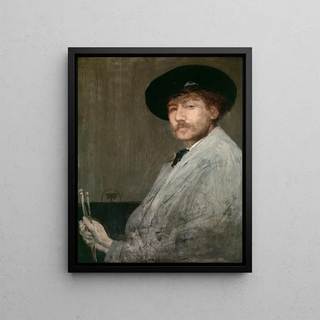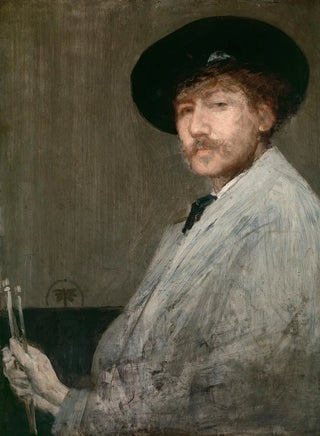Gray Arrangement Portrait of the Painter - James Abbott McNeill Whistler


View from behind

Frame (optional)
Arrangement in Gray Portrait of the Painter - James Abbott McNeill Whistler – Captivating Introduction
The artwork "Arrangement in Gray Portrait of the Painter" by James Abbott McNeill Whistler is an iconic piece that transcends mere portraiture to become a true reflection on art and perception. This painting, which captures the painter himself in an introspective pose, invites the viewer to delve into the artistic universe of the late 19th century. Whistler, through his subtle use of gray tones, manages to create an atmosphere that is both serene and emotionally charged. This art print of the work allows for a rediscovery of the very essence of artistic creation, while offering an entry point into the artist's intimacy.
Style and uniqueness of the work
One of the most fascinating aspects of "Arrangement in Gray Portrait of the Painter" lies in its unique style, characterized by a monochrome palette that defies the conventions of the time. Whistler, by choosing gray as the dominant color, succeeds in playing with light and shadow, thus creating depth and visual richness that captivate the eye. Every shade of gray seems to tell a story, each brushstroke bearing witness to the artist's exceptional skill. This stylistic choice is not merely an aesthetic matter; it also reflects a desire to move away from traditional representations to explore a form of abstraction. The portrait then becomes an "arrangement," a harmonious composition that invites contemplation rather than simple observation.
The artist and his influence
James Abbott McNeill Whistler is a key figure in art history, recognized not only for his work but also for his role in the Impressionist movement. His avant-garde vision and innovative approach to color and composition profoundly influenced many artists of his time and subsequent generations. Whistler did not merely reproduce reality; he sought to capture the very essence of emotions and atmospheres. His famous adage, "art is an arrangement of colors," perfectly summarizes his artistic philosophy. By focusing on formal beauty and harmony of shades, he paved the way for a new way of seeing and feeling art, inspiring artists like Claude Monet and Edgar Degas to explore

Matte finish

View from behind

Frame (optional)
Arrangement in Gray Portrait of the Painter - James Abbott McNeill Whistler – Captivating Introduction
The artwork "Arrangement in Gray Portrait of the Painter" by James Abbott McNeill Whistler is an iconic piece that transcends mere portraiture to become a true reflection on art and perception. This painting, which captures the painter himself in an introspective pose, invites the viewer to delve into the artistic universe of the late 19th century. Whistler, through his subtle use of gray tones, manages to create an atmosphere that is both serene and emotionally charged. This art print of the work allows for a rediscovery of the very essence of artistic creation, while offering an entry point into the artist's intimacy.
Style and uniqueness of the work
One of the most fascinating aspects of "Arrangement in Gray Portrait of the Painter" lies in its unique style, characterized by a monochrome palette that defies the conventions of the time. Whistler, by choosing gray as the dominant color, succeeds in playing with light and shadow, thus creating depth and visual richness that captivate the eye. Every shade of gray seems to tell a story, each brushstroke bearing witness to the artist's exceptional skill. This stylistic choice is not merely an aesthetic matter; it also reflects a desire to move away from traditional representations to explore a form of abstraction. The portrait then becomes an "arrangement," a harmonious composition that invites contemplation rather than simple observation.
The artist and his influence
James Abbott McNeill Whistler is a key figure in art history, recognized not only for his work but also for his role in the Impressionist movement. His avant-garde vision and innovative approach to color and composition profoundly influenced many artists of his time and subsequent generations. Whistler did not merely reproduce reality; he sought to capture the very essence of emotions and atmospheres. His famous adage, "art is an arrangement of colors," perfectly summarizes his artistic philosophy. By focusing on formal beauty and harmony of shades, he paved the way for a new way of seeing and feeling art, inspiring artists like Claude Monet and Edgar Degas to explore






